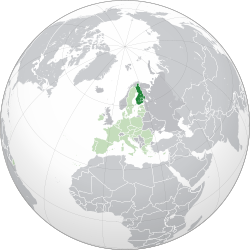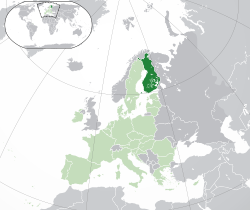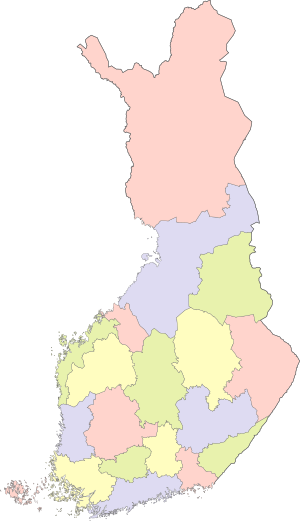
A | B | C | D | E | F | G | H | CH | I | J | K | L | M | N | O | P | Q | R | S | T | U | V | W | X | Y | Z | 0 | 1 | 2 | 3 | 4 | 5 | 6 | 7 | 8 | 9
Republic of Finland | |
|---|---|
| Anthem: Maamme (Finnish) Vårt land (Swedish) (English: "Our Land") | |
Location of Finland (dark green) – in Europe (green & dark grey) | |
| Capital and largest city | Helsinki 60°10′15″N 24°56′15″E / 60.17083°N 24.93750°E |
| Official languages | |
| Recognized national languages | |
| Ethnic groups (2023)[1] | |
| Religion (2023)[1] |
|
| Demonym(s) | |
| Government | Unitary parliamentary republic[2] |
| Alexander Stubb | |
| Petteri Orpo | |
| Jussi Halla-aho | |
| Legislature | Parliament |
| Independence | |
| 29 March 1809 | |
| 6 December 1917 | |
| January – May 1918 | |
| 17 July 1919 | |
| 30 November 1939 – 13 March 1940 | |
| 25 June 1941 – 19 September 1944 | |
| 1 January 1995 | |
• Joined NATO | 4 April 2023 |
| Area | |
• Total | 338,145[4] km2 (130,559 sq mi) (65th) |
• Water (%) | 9.71 (2015)[5] |
| Population | |
• 2023 estimate | |
• Density | 18.4/km2 (47.7/sq mi) (213th) |
| GDP (PPP) | 2023 estimate |
• Total | |
• Per capita | |
| GDP (nominal) | 2023 estimate |
• Total | |
• Per capita | |
| Gini (2023) | low |
| HDI (2022) | very high (12th) |
| Currency | Euro (€) (EUR) |
| Time zone | UTC+2 (EET) |
• Summer (DST) | UTC+3 (EEST) |
| Date format | dd.mm.yyyy[9] |
| Driving side | right[10] |
| Calling code | +358 |
| ISO 3166 code | FI |
| Internet TLD | .fi, .axa, .eub |
| |
Finland,[a] officially the Republic of Finland,[b][c] is a Nordic country in Northern Europe. It borders Sweden to the northwest, Norway to the north, and Russia to the east, with the Gulf of Bothnia to the west and the Gulf of Finland to the south, opposite Estonia. Finland covers an area of 338,145 square kilometres (130,559 sq mi)[4] and has a population of 5.6 million. Helsinki is the capital and largest city. The vast majority of the population are ethnic Finns. The official languages are Finnish and Swedish, of which 84.9 percent and 5.1 percent of the population speak the first as their mother tongue.[1][11] Finland's climate varies from humid continental in the south to boreal in the north. The land cover is predominantly boreal forest biome, with more than 180,000 recorded lakes.[12][13]
Finland was first settled around 9000 BC after the last Ice Age.[14] During the Stone Age, various cultures emerged, distinguished by different styles of ceramics. The Bronze Age and Iron Ages were marked by contacts with other cultures in Fennoscandia and the Baltic region.[15] From the late 13th century, Finland became part of the Swedish Empire as a result of the Northern Crusades. In 1809, as a result of the Finnish War, Finland was captured from Sweden and became a Grand Duchy of Finland, an autonomous state ruled by the Russian Empire. During this period, Finnish art flourished and the idea of full independence began to take hold. In 1906, Finland became the first European state to grant universal suffrage, and the first in the world to give all adult citizens the right to run for public office.[16][note 2] Following the Russian Revolution of 1917, Finland declared its full independence. In 1918 the young nation was divided by the Finnish Civil War. During World War II, Finland fought against the Soviet Union in the Winter War and the Continuation War, and later against Nazi Germany in the Lapland War. As a result, it lost parts of its territory but retained its independence.
Finland remained a largely agricultural country until the 1950s. After World War II, it industrialised quickly and established an advanced economy, with a welfare state built on the Nordic model. This allowed the country to experience overall prosperity and high per capita income.[17] During the Cold War, Finland officially embraced a policy of neutrality. Since then, it has become a member of the European Union in 1995, the Eurozone in 1999, and NATO in 2023. Finland is a member of various international organisations, such as the United Nations, the Nordic Council, the Schengen Area, the Council of Europe, the World Trade Organization, and the Organisation for Economic Co-operation and Development (OECD). The nation performs exceedingly well in national performance metrics, including education, economic competitiveness, civil liberties, quality of life, and human development.[18][19][20][21]
History
Prehistory
The area that is now Finland was settled in, at the latest, around 8,500 BC during the Stone Age towards the end of the last glacial period. The artefacts the first settlers left behind present characteristics that are shared with those found in Estonia, Russia, and Norway.[22] The earliest people were hunter-gatherers, using stone tools.[23]
The first pottery appeared in 5200 BC, when the Comb Ceramic culture was introduced.[24] The arrival of the Corded Ware culture in Southern coastal Finland between 3000 and 2500 BC may have coincided with the start of agriculture.[25] Even with the introduction of agriculture, hunting and fishing continued to be important parts of the subsistence economy.
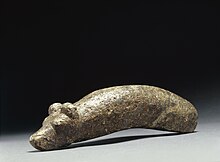
In the Bronze Age, permanent all-year-round cultivation and animal husbandry spread, but the cold climate slowed the change.[28] The Seima-Turbino phenomenon brought the first bronze artefacts to the region and possibly also the Finno-Ugric languages.[28][29] Commercial contacts that had so far mostly been to Estonia started to extend to Scandinavia. Domestic manufacture of bronze artefacts started 1300 BC.[30]
In the Iron Age, population grew. Finland Proper was the most densely populated area. Commercial contacts in the Baltic Sea region grew and extended during the eighth and ninth centuries. Main exports from Finland were furs, slaves, castoreum, and falcons to European courts. Imports included silk and other fabrics, jewelry, Ulfberht swords, and, in lesser extent, glass. Production of iron started approximately in 500 BC.[31] At the end of the ninth century, indigenous artefact culture, especially weapons and women's jewelry, had more common local features than ever before. This has been interpreted to be expressing common Finnish identity.[32]
An early form of Finnic languages spread to the Baltic Sea region approximately 1900 BC. Common Finnic language was spoken around Gulf of Finland 2000 years ago. The dialects from which the modern-day Finnish language was developed came into existence during the Iron Age.[33] Although distantly related, the Sami people retained the hunter-gatherer lifestyle longer than the Finns. The Sami cultural identity and the Sami language have survived in Lapland, the northernmost province.
The name Suomi (Finnish for 'Finland') has uncertain origins, but a common etymology with saame (the Sami) has been suggested.[34][35] In the earliest historical sources, from the 12th and 13th centuries, the term Finland refers to the coastal region around Turku. This region later became known as Finland Proper in distinction from the country name Finland.[36]
Swedish era
The 12th and 13th centuries were a violent time in the northern Baltic Sea. The Livonian Crusade was ongoing and the Finnish tribes such as the Tavastians and Karelians were in frequent conflicts with Novgorod and with each other. Also, during the 12th and 13th centuries several crusades from the Catholic realms of the Baltic Sea area were made against the Finnish tribes. Danes waged at least three crusades to Finland, in 1187 or slightly earlier,[37] in 1191 and in 1202,[38] and Swedes, possibly the so-called second crusade to Finland, in 1249 against Tavastians and the third crusade to Finland in 1293 against the Karelians. The so-called first crusade to Finland, possibly in 1155, most likely never occurred.[39]
As a result of the crusades (mostly with the second crusade led by Birger Jarl) and the colonization of some Finnish coastal areas with Christian Swedish population during the Middle Ages,[40] Finland gradually became part of the kingdom of Sweden and the sphere of influence of the Catholic Church.[41] Under Sweden, Finland was annexed as part of the cultural order of Western Europe.[42]

Swedish was the dominant language of the nobility, administration, and education; Finnish was chiefly a language for the peasantry, clergy, and local courts in predominantly Finnish-speaking areas. During the Protestant Reformation, the Finns gradually converted to Lutheranism.[43]
In the 16th century, a bishop and Lutheran Reformer Mikael Agricola published the first written works in Finnish;[44] and Finland's current capital city, Helsinki, was founded by King Gustav Vasa in 1555.[45] The first university in Finland, the Royal Academy of Turku, was established by Queen Christina of Sweden at the proposal of Count Per Brahe in 1640.[46][47]
The Finns reaped a reputation in the Thirty Years' War (1618–1648) as a well-trained cavalrymen called "Hakkapeliitta".[48] Finland suffered a severe famine in 1695–1697, during which about one third of the Finnish population died,[49] and a devastating plague a few years later.
In the 18th century, wars between Sweden and Russia twice led to the occupation of Finland by Russian forces, times known to the Finns as the Greater Wrath (1714–1721) and the Lesser Wrath (1742–1743).[50][49] It is estimated that almost an entire generation of young men was lost during the Great Wrath, due mainly to the destruction of homes and farms, and the burning of Helsinki.[51]
Grand Duchy of Finland
The Swedish era ended with the Finnish War of 1809. On 29 March 1809, after being conquered by the armies of Alexander I of Russia, Finland became an autonomous Grand Duchy under the rule of the Russian Empire, as recognised by the Diet of Porvoo. This situation continued until the end of 1917.[50] In 1812 Alexander I incorporated the Russian province of Vyborg into the Grand Duchy of Finland. In 1854, Finland became involved in Russia's involvement in the Crimean War when the British and French navies bombed the Finnish coast and Åland during the so-called Åland War.[52]

Although Swedish was still widely spoken, the Finnish language began to gain recognition during this period. From the 1860s, a strong Finnish nationalist movement, known as the Fennoman movement, grew. One of the movement's most prominent leaders was the philosopher and politician J.V. Snellman, who worked to stabilise the status of the Finnish language and its own currency, the Finnish markka, in the Grand Duchy of Finland.[52][53] Milestones included the publication of what would become Finland's national epic, the Kalevala, in 1835 and the legal equality of the Finnish language with Swedish in 1892. In the spirit of Adolf Ivar Arwidsson - "we are not Swedes, we do not want to become Russians, so let us be Finns" - a Finnish national identity was established.[54] Nevertheless, there was no real independence movement in Finland until the early 20th century.[55]
The Finnish famine of 1866-1868 occurred after freezing temperatures in early September devastated crops and killed around 15% of the population, making it one of the worst famines in European history.[56] The famine led the Russian Empire to relax financial regulations, and investment increased in the following decades. Economic development was rapid.[57] The gross domestic product (GDP) per capita was still half of that of the United States and a third of that of Britain.[57]
From 1869 to 1917, the Russian Empire pursued a policy known as the "Russification of Finland". This policy was suspended between 1905 and 1908. In 1906, universal suffrage was introduced in the Grand Duchy of Finland. However, relations between the Grand Duchy of Finland and the Russian Empire soured when the Russian government began to take steps to restrict Finland's special status and autonomy. For example, universal suffrage was virtually meaningless in practice, as the Tsar did not have to approve any of the laws passed by the Finnish parliament. The desire for independence gained ground, first among radical liberals[58] and socialists, partly driven by a declaration called the February Manifesto by the last Tsar of the Russian Empire, Nicholas II, on 15 February 1899.[59]
Civil war and early independence
After the February Revolution of 1917, Finland's position as a Grand Duchy under the rule of the Russian Empire was questioned. The Finnish parliament, controlled by the Social Democrats, passed the so-called Power Act to give the parliament supreme authority. This was rejected by the Russian Provisional Government, which decided to dissolve the parliament.[60] New elections were held in which the right-wing parties won by a small majority. Some social democrats refused to accept the result, claiming that the dissolution of parliament and the subsequent elections were extra-legal. The two almost equally powerful political blocs, the right-wing parties and the Social Democratic Party, were deeply divided.

The October Revolution in Russia changed the geopolitical situation once again. Suddenly the right-wing parties in Finland began to reconsider their decision to block the transfer of supreme executive power from the Russian government to Finland when the Bolsheviks came to power in Russia. The right-wing government, led by Prime Minister P. E. Svinhufvud, presented the Declaration of Independence on 4 December 1917, which was officially approved by the Finnish Parliament on 6 December. The Russian Soviet Federative Socialist Republic (RSFSR), led by Vladimir Lenin, recognised full independence on 4 January 1918.[61]
On 27 January 1918 the government began to disarm the Russian forces in Ostrobothnia. The socialists took control of southern Finland and Helsinki, but the white government continued in exile in Vaasa.[62][63] This led to a short but bitter civil war. The Whites, backed by Imperial Germany, prevailed over the Reds[64] and their self-proclaimed Finnish Socialist Workers' Republic.[65] After the war, tens of thousands of Reds were interned in camps where thousands were executed or died of malnutrition and disease. A deep social and political enmity was sown between the Reds and the Whites that would last until the Winter War and beyond.[66][67] The civil war and the activist expeditions to Soviet Russia in 1918–1920, known as the "Kinship Wars", strained relations with the East.[68][69]
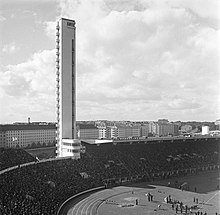
After a brief experiment with monarchy, when an attempt to make Prince Frederick Charles of Hesse King of Finland failed, Finland became a presidential republic, with K. J. Ståhlberg elected as its first president in 1919. A liberal nationalist with a legal background, Ståhlberg anchored the state in liberal democracy, promoted the rule of law and initiated internal reforms.[70] Finland was also one of the first European countries to strongly promote women's equality, with Miina Sillanpää becoming the first female minister in Finnish history in Väinö Tanner's cabinet in 1926–1927.[71] The Finnish-Russian border was established in 1920 by the Treaty of Tartu, which largely followed the historical border but gave Finland Pechenga (Finnish: Petsamo) and its Barents Sea port.[50] Finnish democracy survived Soviet coup attempts and the anti-communist Lapua movement.
In 1917 there were three million people in the country. After the civil war, a credit-based land reform was introduced, increasing the proportion of the population with capital.[57] About 70% of the workforce was employed in agriculture and 10% in industry.[72]
World War II
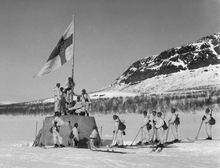
The Soviet Union launched the Winter War on 30 November 1939 to annex Finland in accordance with the Molotov-Ribbentrop Pact with Nazi Germany to divide Europe into spheres of influence between the two dictatorships.[73][74] The Finnish Democratic Republic was set up by Joseph Stalin at the beginning of the war to govern Finland after the Soviet conquest.[75] The Red Army was defeated in numerous battles, most notably the Battle of Suomussalmi. After two months of negligible progress on the battlefield, as well as heavy losses in men and material,[76] Soviet forces began to advance in February and reached Vyborg (Finnish: Viipuri) in March. The Moscow Peace Treaty was signed on 12 March 1940, and the war ended the following day. Finland had defended its independence, but ceded 9% of its territory to the Soviet Union.
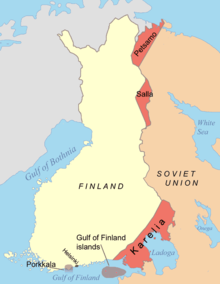
Hostilities resumed in June 1941 with the Continuation War, when Finland allied itself with Germany following the latter's invasion of the Soviet Union; the main aim was to regain the territory lost to the Soviets barely a year earlier.[77] Finnish troops occupied Eastern Karelia from 1941 to 1944. The massive Soviet Vyborg-Petrozavodsk offensive in the summer of 1944 led to a breakthrough until the Finns finally repulsed it at Tali-Ihantala. This partial Soviet success led to a stalemate and later an armistice. This was followed by the Lapland War of 1944–1945, when Finland fought retreating German forces in northern Finland.
The Armistice and treaty signed with the Soviet Union in 1944 and 1948 included Finnish obligations, restraints, and reparations, as well as further territorial concessions. As a result of the two wars, Finland lost 12% of its land area, 20% of its industrial capacity, its second largest city, Vyborg (Finnish: Viipuri), and the ice-free port of Liinakhamari (Finnish: Liinahamari). The Finns lost 97,000 soldiers and were forced to pay war reparations of $300 million ($4.1 billion in 2023). However, the country avoided occupation by Soviet forces and managed to retain its independence. Along with Great Britain, Finland emerged from the war as the only European country to have taken part in hostilities, but it was never occupied and managed to preserve its democracy throughout.[78]
For a few decades after 1944, the Communists were a strong political party. Furthermore, the Soviet Union persuaded Finland to refuse Marshall Plan aid. However, in the hope of preserving Finland's independence, the United States provided secret development aid and supported the Social Democratic Party.[79]
After the war
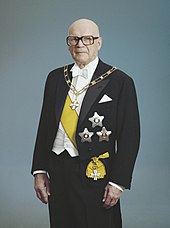
The development of trade with the Western powers, such as the United Kingdom, and the payment of reparations to the Soviet Union led to Finland's transformation from a primarily agrarian society to an industrialised one. Valmet, originally a shipyard and then several metal workshops, was established to produce materials for war reparations. After the reparations were paid, Finland continued to trade with the Soviet Union as part of bilateral trade.
In 1950, 46% of Finnish workers were employed in agriculture and a third lived in urban areas, but new jobs in manufacturing, services and trade quickly attracted people to the cities.[80] The average number of births per woman fell from a baby boom peak of 3.5 in 1947 to 1.5 in 1973. As the baby boomers entered the workforce, the economy failed to create jobs fast enough and hundreds of thousands emigrated to more industrialised Sweden, with emigration peaking in 1969 and 1970.[80] Finland participated in trade liberalisation in the World Bank, the International Monetary Fund and the General Agreement on Tariffs and Trade.
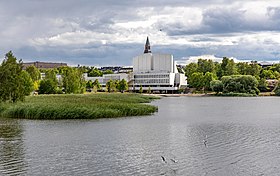
Officially neutral, Finland was in the grey zone between the Western countries and the Soviet bloc during the Cold War. The YYA treaty (Finno-Soviet Pact of Friendship, Cooperation and Mutual Assistance) gave the Soviet Union some leverage in Finnish domestic politics. President Urho Kekkonen used it extensively against his opponents. From 1956 he had a virtual monopoly on relations with the Soviet Union, which was crucial to his continued popularity. In politics, there was a tendency to avoid any policy or statement that could be interpreted as anti-Soviet. This phenomenon was dubbed "Finlandisation" by the West German press.[81]
A market economy was maintained in Finland. Various industries benefited from trade privileges with the Soviets. Economic growth was rapid in the post-war period, and by 1975 Finland's GDP per capita was the 15th highest in the world. During the 1970s and 1980s, Finland built one of the most extensive welfare states in the world. Finland negotiated a treaty with the European Economic Community (EEC, a forerunner of the European Union) that largely eliminated tariffs with the EEC from 1977. In 1981, President Urho Kekkonen's failing health forced him to retire after 25 years in office.
Miscalculated macroeconomic decisions, a banking crisis, the collapse of its largest trading partner, the Soviet Union, and a global economic downturn caused a deep recession in Finland in the early 1990s. The recession bottomed out in 1993 and Finland enjoyed more than a decade of steady economic growth.[82] After the collapse of the Soviet Union, Finland began to integrate more closely with the West.[83] Finland joined the European Union in 1995 and the euro zone in 1999. Much of the economic growth of the late 1990s was fuelled by the success of mobile phone manufacturer Nokia.[42]
21st century
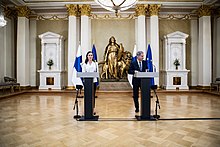
The Finnish people elected Tarja Halonen in the 2000 Presidential election, making her the first female President of Finland.[84] Her predecessor, President Martti Ahtisaari, later won the Nobel Peace Prize in 2008. Financial crises paralysed Finland's exports in 2008, leading to weaker economic growth throughout the decade.[85][86] Sauli Niinistö was elected President of Finland from 2012 until 2024, when Alexander Stubb took over.[87][88]
Finnish support for NATO rose sharply after the Russian invasion of Ukraine in 2022. Before February 2022, opinion polls showed a narrow but decisive majority against NATO membership;[89] by April, a supermajority was in favour of membership.[90][91][92][93] On 11 May 2022, Finland signed a mutual security pact with the United Kingdom.[94] On 12 May, Finland's President and Prime Minister called for NATO membership "without delay".[95] Subsequently, on 17 May, the Finnish Parliament voted 188–8 in favour of Finland's accession to NATO.[96] Finland became a member of NATO on 4 April 2023.[97]
Geography
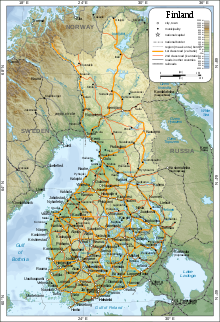

Lying approximately between latitudes 60° and 70° N, and longitudes 20° and 32° E, Finland is one of the world's northernmost countries. Of world capitals, only Reykjavík lies more to the north than Helsinki. The distance from the southernmost point – Hanko in Uusimaa – to the northernmost – Nuorgam in Lapland – is 1,160 kilometres (720 mi).

Finland has about 168,000 lakes (of area larger than 500 m2 or 0.12 acres) and 179,000 islands.[98] Its largest lake, Saimaa, is the fourth largest in Europe. The Finnish Lakeland is the area with the most lakes in the country;[13] many of the major cities in the area, most notably Tampere, Jyväskylä and Kuopio, are located near the large lakes. The Finnish coastline is speckled with the world's largest archipelago, encompassing more than 50,000 islands, greatest concentration of which is found in the southwest, in the Archipelago Sea between continental Finland and the main island of Åland.[99]
Much of the geography of Finland is a result of the Ice Age. The glaciers were thicker and lasted longer in Fennoscandia compared with the rest of Europe. The eroding effects have contributed to a mostly flat landscape in Finland, characterized by hills. However, in the northern regions, including areas bordering the Scandinavian Mountains, the terrain features mountainous elevations. At 1,324 metres (4,344 ft), Halti is the highest point in Finland. It is found in the north of Lapland at the border between Finland and Norway. The highest mountain whose peak is entirely in Finland is Ridnitšohkka at 1,316 m (4,318 ft), directly adjacent to Halti.
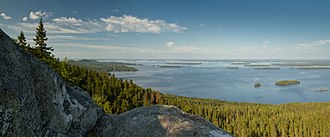
The retreating glaciers have left the land with morainic deposits in formations of eskers. These are ridges of stratified gravel and sand, running northwest to southeast, where the ancient edge of the glacier once lay. Among the biggest of these are the three Salpausselkä ridges that run across southern Finland.
Having been compressed under the enormous weight of the glaciers, terrain in Finland is rising due to the post-glacial rebound. The effect is strongest around the Gulf of Bothnia, where land steadily rises about 1 cm (0.4 in) a year. As a result, the old sea bottom turns little by little into dry land: the surface area of the country is expanding by about 7 square kilometres (2.7 sq mi) annually.[100] Relatively speaking, Finland is rising from the sea.[101]
The landscape is covered mostly by coniferous taiga forests and fens, with little cultivated land. Of the total area, 10% is lakes, rivers, and ponds, and 78% is forest. The forest consists of pine, spruce, birch, and other species.[102] Finland is the largest producer of wood in Europe and among the largest in the world. The most common type of rock is granite. It is a ubiquitous part of the scenery, visible wherever there is no soil cover. Moraine or till is the most common type of soil, covered by a thin layer of humus of biological origin. Podzol profile development is seen in most forest soils except where drainage is poor. Gleysols and peat bogs occupy poorly drained areas.
Biodiversity

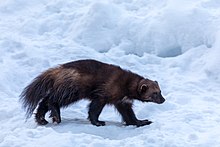

Phytogeographically, Finland is shared between the Arctic, central European, and northern European provinces of the Circumboreal Region within the Boreal Kingdom. According to the WWF, the territory of Finland can be subdivided into three ecoregions: the Scandinavian and Russian taiga, Sarmatic mixed forests, and Scandinavian Montane Birch forest and grasslands.[104] Taiga covers most of Finland from northern regions of southern provinces to the north of Lapland. On the southwestern coast, south of the Helsinki-Rauma line, forests are characterized by mixed forests, that are more typical in the Baltic region. In the extreme north of Finland, near the tree line and Arctic Ocean, Montane Birch forests are common. Finland had a 2018 Forest Landscape Integrity Index mean score of 5.08/10, ranking it 109th globally out of 172 countries.[105]
Similarly, Finland has a diverse and extensive range of fauna. There are at least sixty native mammalian species, 248 breeding bird species, over 70 fish species, and 11 reptile and frog species present today, many migrating from neighbouring countries thousands of years ago. Large and widely recognized wildlife mammals found in Finland are the brown bear, grey wolf, wolverine, and elk. Three of the more striking birds are the whooper swan, a large European swan and the national bird of Finland; the Western capercaillie, a large, black-plumaged member of the grouse family; and the Eurasian eagle-owl. The latter is considered an indicator of old-growth forest connectivity, and has been declining because of landscape fragmentation.[106] Around 24,000 species of insects are prevalent in Finland some of the most common being hornets with tribes of beetles such as the Onciderini also being common. The most common breeding birds are the willow warbler, common chaffinch, and redwing.[107] Of some seventy species of freshwater fish, the northern pike, perch, and others are plentiful. Atlantic salmon remains the favourite of fly rod enthusiasts.
The endangered Saimaa ringed seal, one of only three lake seal species in the world, exists only in the Saimaa lake system of southeastern Finland, down to only 390 seals today.[108][109] The species has become the emblem of the Finnish Association for Nature Conservation.[110]
A third of Finland's land area originally consisted of moorland, about half of this area has been drained for cultivation over the past centuries.[111]
Climate

The main factor influencing Finland's climate is the country's geographical position between the 60th and 70th northern parallels in the Eurasian continent's coastal zone. In the Köppen climate classification, the whole of Finland lies in the boreal zone, characterized by warm summers and freezing winters. Within the country, the temperateness varies considerably between the southern coastal regions and the extreme north, showing characteristics of both a maritime and a continental climate. Finland is near enough to the Atlantic Ocean to be continuously warmed by the Gulf Stream. The Gulf Stream combines with the moderating effects of the Baltic Sea and numerous inland lakes to explain the unusually warm climate compared with other regions that share the same latitude, such as Alaska, Siberia, and southern Greenland.[112]

Winters in southern Finland (when mean daily temperature remains below 0 °C or 32 °F) are usually about 100 days long, and in the inland the snow typically covers the land from about late November to April, and on the coastal areas such as Helsinki, snow often covers the land from late December to late March.[113] Even in the south, the harshest winter nights can see the temperatures fall to −30 °C (−22 °F) although on coastal areas like Helsinki, temperatures below −30 °C (−22 °F) are rare. Climatic summers (when mean daily temperature remains above 10 °C or 50 °F) in southern Finland last from about late May to mid-September, and in the inland, the warmest days of July can reach over 35 °C (95 °F).[112] Although most of Finland lies on the taiga belt, the southernmost coastal regions are sometimes classified as hemiboreal.[114]
In northern Finland, particularly in Lapland, the winters are long and cold, while the summers are relatively warm but short. On the most severe winter days in Lapland can see the temperature fall to −45 °C (−49 °F). The winter of the north lasts for about 200 days with permanent snow cover from about mid-October to early May. Summers in the north are quite short, only two to three months, but can still see maximum daily temperatures above 25 °C (77 °F) during heat waves.[112] No part of Finland has Arctic tundra, but Alpine tundra can be found at the fells Lapland.[114]
The Finnish climate is suitable for cereal farming only in the southernmost regions, while the northern regions are suitable for animal husbandry.[115]
A quarter of Finland's territory lies within the Arctic Circle and the midnight sun can be experienced for more days the farther north one travels. At Finland's northernmost point, the sun does not set for 73 consecutive days during summer and does not rise at all for 51 days during winter.[112]
Regions
Finland consists of 19 regions (maakunta). The counties are governed by regional councils which serve as forums of cooperation for the municipalities of a county. The main tasks of the counties are regional planning and development of enterprise and education. In addition, the public health services are usually organized based on counties. Regional councils are elected by municipal councils, each municipality sending representatives in proportion to its population. In addition to inter-municipal cooperation, which is the responsibility of regional councils, each county has a state Employment and Economic Development Centre which is responsible for the local administration of labour, agriculture, fisheries, forestry, and entrepreneurial affairs. Historically, counties are divisions of historical provinces of Finland, areas that represent local dialects and culture more accurately.
Six Regional State Administrative Agencies are responsible for one of the counties called alue in Finnish; in addition, Åland was designated a seventh county.[116]
|



